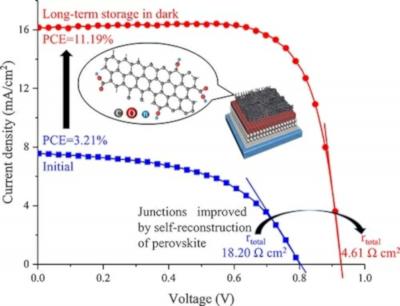Scientists at Tokyo Institute of Technology (Tokyo Tech) have conducted an in-depth study on how carbon nanotubes with oxygen-containing groups can be used to enhance the performance of perovskite solar cells. The discovery of perovskites' self-recrystallization ability could lead to the improvement of perovskite solar cells.

A major obstacle that stands before perovskite solar cells is reproducibility. This means that it is hard to consistently create perovskite crystal layers free of defects and holes, which means that deviations from design values are likely to occur and reduce their efficiency. However, researchers have found that the efficiency of these cells can be boosted by combining perovskite with carbon nanotubes (CNTs). The mechanism by which CNTs and perovskite bond together and how this affects the performance of CNT perovskite solar cells has not been studied in depth. In addition, the ability of pure CNTs to bond to perovskite is not very good, and this could compromise the structural and conducting properties at the interface of both materials.
This research consisted of several experiments that provided insight into many aspects of CNT'perovskite interactions. First, they demonstrated the superior electrical performance of cells with functionalized CNTs over those with pure CNTs and found evidence supporting that larger crystals and fewer surface defects occur when using functionalized CNTs.
Then, the team inferred that the perovskite in the cells would undergo a recrystallization process if stored in the dark, and that the presence of the functional groups in CNT would have a significant effect on this process. This was confirmed by storing the cells for over two months and measuring their electrical characteristics afterwards. "We have discovered the self-recrystallization ability of perovskite at room temperature, whose morphology greatly improved after long-term storage. However, the most interesting result was the ability of functionalized CNTs to make use of the self-recrystallization nature to form a stronger junction between the perovskite and CNTs through the reconstruction" explains Prof. Waki.
Most notably, the functionalized CNTs greatly improved the contact between the two materials and the functional groups served as a protection against attacks from moisture on the perovskite, allowing the self-recrystallization and interface reconstruction to proceed without noticeable degradation. The research team also found that the recrystallization process could be immensely sped up by constantly subjecting the solar cells to frequent measurements, but this ultimately affected their stability and degraded them.
Such in-depth studies on perovskite solar cells and ways to enhance them can be very valuable since they get scientists closer to realizing new sources of clean energy. "We hope this study contributes toward the production of perovskites with higher stability and reproducibility," concludes Prof. Waki.

